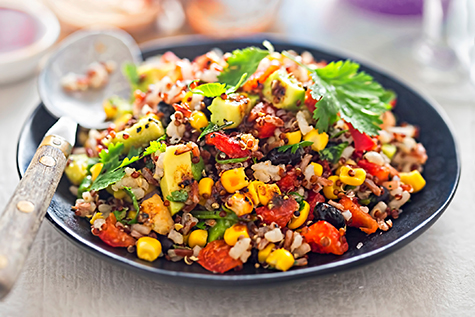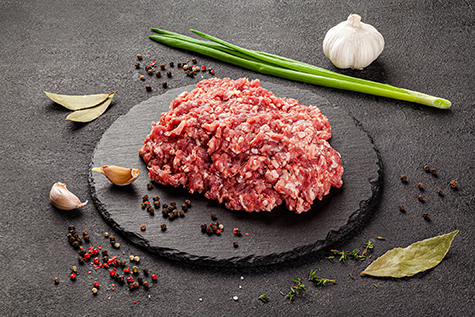Try One-bowl Meals from Around the World

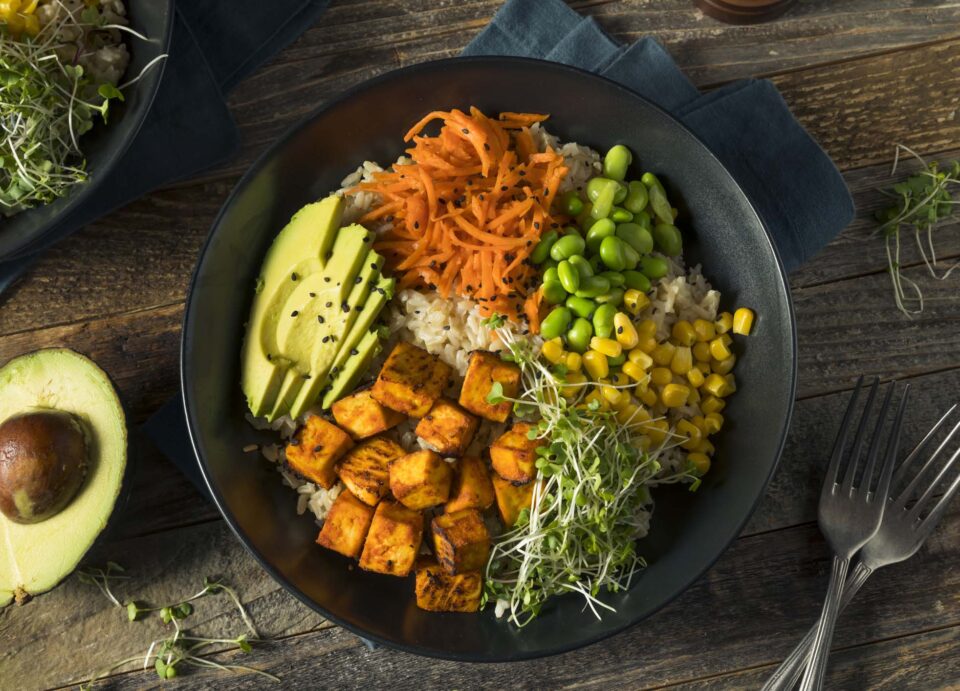
The growing trend of one-bowl meals just keeps going. I enjoy creating a blend of flavors, spices and textures in my bowl recipes and find them to be delicious, satisfying meals.
The legend of the Buddha carrying a bowl with him on his journeys and accepting food as donations to be eaten at the end of the day is the origin of the Asian-inspired “Buddha Bowl.” If the Enlightened One had lived in Morocco, a Buddha Bowl would probably have contained couscous and the spice blend, zaatar. Or if he travelled throughout Peru, at the end of the day his bowl might have contained quinoa and purple potatoes. The point is, a bowl filled with grain, colorful vegetables and occasionally meat, fish or chicken can reflect the flavors and cuisine of any part of the world.
Pan-Asian 21st Century Buddha Bowl
Serves 4
This bowl contains several superfoods, including purple cabbage, which contains a compound called flavonoids that has powerful antioxidant properties. The snow peas or sugar snap peas provide fiber, carotenoids that boost eye health, calcium, potassium and a little vitamin C. The avocados are loaded with healthy unsaturated fats and the edamame are a good source of plant protein, so eat up!
Ingredients
1 ¼ cups brown rice, rinsed
1 ½ cups shelled edamame (frozen will do)
1 ½ cups trimmed and roughly chopped sugar snap peas or snow peas
1 to 2 Tbs. reduced-sodium tamari or soy sauce, to taste
4 cups chopped red cabbage, spinach or kale
2 ripe avocados, halved, pitted and thinly sliced into long strips
For garnish:
1 Persian cucumber, sliced thin
2 radishes, sliced thin
4-5 green onions, sliced
8-12 Cherry tomatoes, sliced in half (optional)
Juice of 1 lime
1 Tbs. toasted sesame seeds
Directions
1. Bring about 4 quarts of water to boil. Once the water is boiling, add the rice and cook according to package instructions, about 20 minutes. Add the edamame and cook for 2 more minutes. Add the snap peas and cook an additional 1-2 minutes.
2. Drain any excess water. In the pot, season the rice and vegetables to taste with 1 to 2 tablespoons of tamari or soy sauce; stir to combine.
3. Divide the rice/vegetable mixture and raw cabbage (or spinach or kale) into 4 bowls. Arrange cucumber, tomatoes, and radish slices along the edge of the bowl. Drizzle lightly with carrot ginger dressing (recipe below) and top with sliced green onion.
4. Slice the peeled, seeded avocados into thin strips and drizzle with lime juice.
5. To serve, place the avocado slices evenly into the bowls. Sprinkle with sesame seeds.
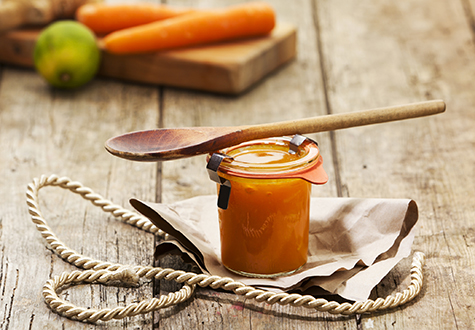 Carrot Ginger Dressing
Carrot Ginger Dressing
Makes about 1 ½ cups
Ingredients
⅓ cup extra-virgin olive oil
⅓ cup rice vinegar
2 large carrots, peeled and roughly chopped (about ⅔ cup)
2 Tbs. peeled and roughly chopped fresh ginger
2 Tbs. lime juice
1 Tbs. plus 1 teaspoon honey*
1 ½ tsp. toasted sesame oil
¼ tsp. salt, more to taste
*To make this recipe vegan, use maple or agave syrup.
Instructions
1. Boil the chopped carrots in rapidly boiling water for about 2-3 minutes, until just starting to become tender. Drain and place in an ice bath to cool.
2. Combine the cooled carrots and all the dressing ingredients in a blender or food processor. Blend until completely smooth. Taste, and add more salt if needed. If too tart, add more honey.
3. This dressing keeps well in the refrigerator in an air-tight jar for 1-2 weeks.
Mexican Cuenco de Maíz Callejero
Serves 4
In summer, the corn and tomatoes are superb and now’s the time to take advantage. Mexican “street corn” (maíz callejero) is generally ears roasted, then slathered with chili powder and mayonnaise. This street corn cuenco or bowl treats the corn with a lighter touch and includes black beans (those antioxidant-laden flavonoids again), brown rice for fiber and trace minerals, and the crunch of Romaine. The fresh tomatoes in the pico de gallo combined with the olive oil and the avocado help make available lycopene, which helps protect against many types of cancer.
Ingredients
1 cup brown rice
4 cups chopped romaine lettuce
1 (15-ounce) can black beans, drained and rinsed
2 avocados, halved, peeled, seeded and thinly sliced
1 cup jicama, peeled and cubed
½ cup fresh cilantro leaves
1 lime, cut into wedges
For the Corn:
4 ears corn, shucked and rinsed
2 Tbs. olive oil
½ tsp. coriander
¼ tsp. cumin
½ tsp, chili powder
1 jalapeño, seeded and diced
2 cloves garlic, minced
Juice of 1 lime
For the Pico de Gallo:
2 cups grape tomatoes, halved
¼ cup diced red onion
2 Tbs. chopped fresh cilantro leaves
1 clove garlic, pressed
Juice of 1 lime
1 ½ tsp. olive oil
Kosher salt, to taste
Directions
1. Preheat a stovetop grill to medium high heat.
2. Add corn to the grill and cook, turning occasionally, until cooked through and charred, about 10-12 minutes; let cool before cutting the corn kernels off the cobs.
3. Put the olive oil in a large skillet over medium heat. Add the jalapeño and cook for 1-2 minutes. Add the corn, coriander, cumin, chili powder and garlic. Cook, stirring occasionally, until corn is heated through about 3-5 minutes.
4. For the pico de gallo, combine tomatoes, red onion, cilantro, garlic, lime juice, olive oil and salt in a medium bowl; set aside.
5. In a large saucepan, bring 2 cups of water to a boil; add the rice and cook according to package instructions.
6. Divide the cooked rice into 4 bowls. Top with corn mixture, pico de gallo, romaine, black beans and avocado.
7. Garnish with cilantro and lime wedges
South African Bobotie Bowl
Serves 6
Indians have been a part of South African society for 160 years. They were first brought over from South Asia as laborers by Dutch colonists. In the late 19th century, free Indians came to South Africa on their own accord to take advantage of trade and business opportunities. Today, most South Africans of Indian descent live in and around the city of Durban. As a result, there are some unexpected but delicious South African dishes that are very influenced by Indian cuisine.
Bobotie is high in protein because of the ground beef and has the delightful combination of sweet and savory flavors.
Ingredients
1⁄4 cup sliced almonds
2 Tbs. olive oil
2 lbs. ground sirloin
1 bay leaf
2 celery stalks, chopped
2 carrots, chopped
1 medium onion, finely chopped
6 mini sweet peppers, seeded and chopped
3 garlic cloves, chopped
salt & freshly ground black pepper to taste
1⁄4 cup golden raisins
1⁄2 cup mango chutney
1 cup beef broth
2 Tbs. mild curry paste or curry powder
1 tsp. turmeric
1 1⁄2 tsp. coriander
1 tsp. lemon zest
4 large eggs
1⁄4 cup half-and-half
1 Tbs. unsalted butter
1⁄4 cup cilantro leaves, coarsely chopped
Directions
1. In a dry skillet over medium heat, lightly toast the almonds, about 3 minutes. Set aside.
2. Heat olive oil in a large, deep skillet over medium-high heat. Brown the meat until caramelized, then move it to the sides of the pan.
3. Add the bay leaf, celery, carrots, onion, peppers and garlic to the center of the pan, season with salt and black pepper and cook a couple of minutes, then incorporate into the meat.
4. Add the raisins, chutney, broth, curry paste, turmeric, coriander and lemon zest. Stir vigorously and simmer until the broth evaporates and the meat casserole thickens. Remove the bay leaf, stir in the nuts and reduce the heat to low.
5. Heat a small skillet over medium heat. In a small bowl, beat eggs with a pinch of salt and half-and-half. Add 1/6 of the egg mixture to the pan with a pat of butter and cook like a thin omelet, turning with a fork or thin spatula, about a minute on each side.
6. Transfer to a plate and repeat to make 6 mini omelets.
7. Spoon the meat into bowls and top with the omelets. Garnish with the chopped cilantro and serve.
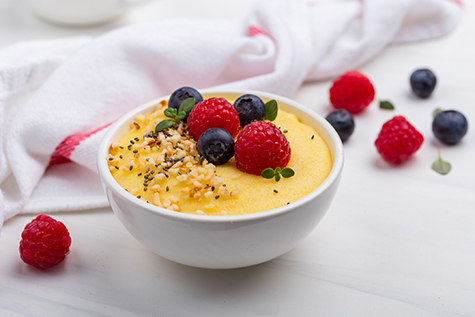 Italian Sweet and Spicy Polenta Breakfast Bowl
Italian Sweet and Spicy Polenta Breakfast Bowl
Makes two large or four small servings
In truth, the only thing “Italian” about this bowl is that it’s made with polenta, which is Italian cornmeal. This is a very adaptable recipe—you can change up the fruit or nuts to include whatever is your favorite or make it vegan by using maple or agave syrup instead of honey, neutral avocado oil in place of butter and almond or cashew “milk” instead of cow’s milk.
There’s lots of fiber in this breakfast and the pecans add monounsaturated fats such as oleic acid along with phenolic antioxidants, which help reduce the risk of heart disease and help prevent breast cancer. Pecans are also a good source of magnesium, which has anti-inflammatory benefits, as does the cinnamon.
Ingredients
3 cups water
1 cup yellow polenta
Dash sea salt
1 Tbs. butter
¼ cup milk (or any nut milk)
½ ripe pear, sliced thin
1 Tbs. coarsely chopped pecans
8 dried apricots, chopped
1-2 Tbs. honey (or agave or maple syrup)
Milk or nut milk to taste
¼ tsp. cinnamon
Directions
1. Check the box directions for preparing the polenta. Cooking times and ratios may vary.
2. Bring water to a boil. Add salt and turn heat down to a simmer. Add dried polenta gradually, whisking constantly so no lumps form. Polenta will begin to thicken immediately. Whisk occasionally for about 6 to 8 minutes. Add butter and milk to the polenta and whisk over low heat until your desired consistency is reached.
3. Divide the polenta into 2 (or 4) bowls and top with the pear slices, nuts, apricots, cinnamon and honey. Or, use other fruits if preferred. Add milk to taste.

